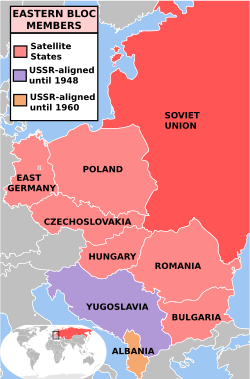
The Brezhnev Doctrine was a Soviet foreign policy that proclaimed that any threat to "socialist rule" in any state of the Soviet Bloc in Central and Eastern Europe was a threat to all of them, and therefore, it justified the intervention of fellow socialist states. It was proclaimed in order to justify the Soviet-led occupation of Czechoslovakia earlier in 1968, with the overthrow of the reformist government there. The references to "socialism" meant control by the communist parties which were loyal to the Kremlin. [1] Soviet leader Mikhail Gorbachev repudiated the doctrine in the late 1980s, as the Kremlin accepted the peaceful overthrow of Soviet rule in all its satellite countries in Eastern Europe. [2]
Contents
- Origins
- 1956 Hungarian Revolution and Soviet invasion
- A peaceful Brezhnev Doctrine
- 1968 Prague Spring
- Formation of the Doctrine
- Brezhnev Doctrine in practice
- Invasion of Afghanistan in 1979
- Renunciation
- Post-Brezhnev Doctrine
- In other Communist countries
- See also
- References
- Bibliography
- External links
The policy was first and most clearly outlined by Sergei Kovalev in a September 26, 1968 Pravda article entitled "Sovereignty and the International Obligations of Socialist Countries". [3] Leonid Brezhnev reiterated it in a speech at the Fifth Congress of the Polish United Workers' Party on November 13, 1968, which stated: "When forces that are hostile to socialism try to turn the development of some socialist country towards capitalism, it becomes not only a problem of the country concerned, but a common problem and concern of all socialist countries." [4]
This doctrine was announced to retroactively justify the invasion of Czechoslovakia in August 1968 that ended the Prague Spring, along with earlier Soviet military interventions, such as the invasion of Hungary in 1956. These interventions were meant to put an end to liberalization efforts and uprisings that had the potential to compromise Soviet hegemony inside the Soviet Bloc, which was considered by the Soviet Union to be an essential and defensive and strategic buffer in case hostilities with NATO were to break out.
In practice, the policy meant that only limited independence of the satellite states' communist parties was allowed and that none would be allowed to compromise the cohesiveness of the Eastern Bloc in any way. That is, no country could leave the Warsaw Pact or disturb a ruling communist party's monopoly on power. Implicit in this doctrine was that the leadership of the Soviet Union reserved, for itself, the power to define "socialism" and "capitalism". Following the announcement of the Brezhnev Doctrine, numerous treaties were signed between the Soviet Union and its satellite states to reassert these points and to further ensure inter-state cooperation. The principles of the doctrine were so broad that the Soviets even used it to justify their military intervention in the communist (but non-Warsaw Pact) nation of Afghanistan in 1979. The Brezhnev Doctrine stayed in effect until it was ended with the Soviet reaction to the Polish crisis of 1980–1981. [5]
Mikhail Gorbachev refused to use military force when Poland held free elections in 1989 and Solidarity defeated the Polish United Workers' Party. [6] It was superseded by the facetiously named Sinatra Doctrine in 1989, alluding to the Frank Sinatra song "My Way". [7] The refusal to intervene in the emancipation of the Eastern European satellite states and the Pan-European Picnic then led to the fall of the Iron Curtain and the largely peaceful collapse of the Eastern Bloc. [8] [9]
